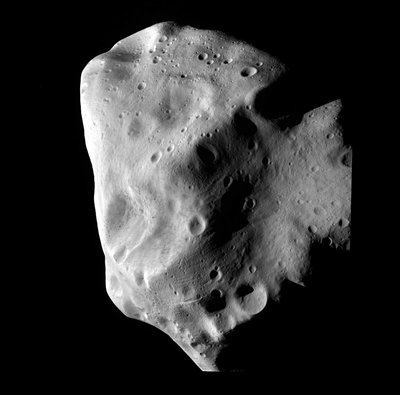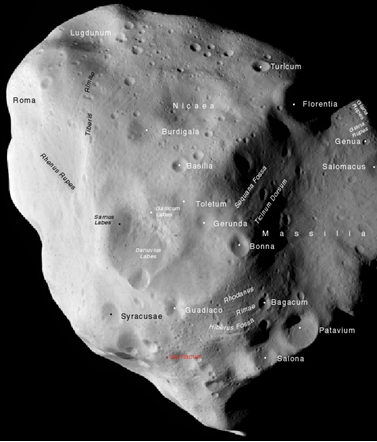New analysis of Lutetia finds evidence for molten interior.
On July 10, 2010, the European Space Agency’s Rosetta probe flew by the asteroid 21 Lutetia, which at the time was the largest asteroid ever to have been visited by a spacecraft. The fly-by occurred 282 million miles from Earth; close-up images taken by the probe revealed cracks and craters running across Lutetia’s surface, evidence of the asteroid’s long and battered history.
Now an international team of researchers from France, Germany, the Netherlands and the United States has analyzed Lutetia’s surface images, and found that underneath its cold and cracked exterior, the asteroid may in fact have once harbored a molten-hot, metallic core. The findings suggest that Lutetia, despite billions of years of impacts, may have retained its original structure — a preserved remnant of the very earliest days of the solar system.
The results are published in a series of three papers in the journals Science and Planetary Space Science (PSS).
Benjamin Weiss, an associate professor of planetary sciences in MIT’s Department of Earth, Atmospheric and Planetary Sciences, says a melted core within Lutetia may exemplify a “hidden diversity” within the greater asteroid belt.
“There might be many bodies that have cores and interesting interiors that we never noticed, because they’re covered by unmelted surfaces,” says Weiss, who is a co-author on both Science papers and lead author for the paper in PSS. “The asteroid belt may be more interesting than it seems on the surface.”
More than a rubble pile
Most asteroids careening through the asteroid belt, between the orbits of Mars and Jupiter, are scrambled versions of their former selves: essentially mashed-up masses of rock and metal that have collided and cooled over billions of years. These rocky conglomerations are relatively small and light, with voids and cracks in their interiors that make them very porous. It had been thought that the vast majority of these bodies never melted to form dense, metallic cores, but instead are just primordial piles of space rocks and dust.
In contrast, the Rosetta team — led by Holger Sierks of the Max-Planck Institute for Solar System Research and Martin Pätzold of the Rheinisches Institut für Umweltforschung, both in Germany — found that Lutetia is extremely dense. The team drew up a model of the asteroid’s shape, based on images taken by the Rosetta probe. The researchers then calculated Lutetia’s volume, mass and finally its density, which they found, in collaboration with the MIT team, to be greater than most meteorite samples measured on Earth.
The asteroid’s density would make sense if it were completely solid, free of voids or cracks. However, Rosetta researchers measured the asteroid’s surface craters and identified huge fractures throughout, suggesting the asteroid is relatively porous, a finding that didn’t quite square with the team’s density measurements — after all, the more porous an object, the less dense it should be.
Weiss and his colleagues, including MIT professor Richard Binzel and former MIT professor Linda T. Elkins-Tanton, now head of the Carnegie Institution for Science’s Department of Terrestrial Magnetism, offered a likely explanation for the discrepancy: Perhaps the space rock contains a dense metallic core, with a once melted interior underneath its fractured crust.
The direct observations from Lutetia may provide evidence for a theory developed last year by Weiss, Elkins-Tanton and MIT’s Maria Zuber. The team studied samples of chondrites, meteorites on Earth that have remained unchanged since their early formation. They found samples from the meteorite Allende that were strongly magnetized, and theorized that such magnetization most likely occurred in an asteroid with a melted, metallic core. The theory was seen as a big shift from the traditional picture of most asteroids as primordial, unmelted objects.
Planetary arrested development
If a metallic core does indeed exist, Lutetia would be the first asteroid known to be partially differentiated: having a melted interior overlain by progressively cooler layers. The asteroid would also represent a snapshot of early planetary development.
As the solar system began to take form 4.5 billion years ago, planets formed from collisions first of dust, then of larger chunks of rock. Numerous chunks remained relatively small, cooling quickly to form asteroids, while others grew with each collision, eventually reaching the size of planets. These large bodies generated an immense amount of heat — but as a new planet melted from the inside, it cooled from the outside, forming a crust around a molten core.
According to Weiss, Lutetia is a case of arrested development. The asteroid may have reached a size large enough to develop and retain a melting core, and then simply avoided the larger collisions that accelerated planet formation.
“The planets … don’t retain a record of these early differentiation processes,” Weiss says. “So this asteroid may be a relic of the first events of melting in a body.”
Erik Asphaug, a professor of planetary science at the University of California at Santa Cruz, studies “hit-and-run” collisions between early planetary bodies. He says the work by Weiss and his colleagues is a solid step toward resolving how certain asteroids like Lutetia may have evolved.
“We’ve had decades of cartoon speculation, and here’s speculation that’s anchored in physical understanding of how the interiors of these bodies would evolve,” says Asphaug, who was not involved in the research. “It’s like getting through the first 100 pages of a novel, and you don’t know where it’s leading, but it feels like the beginnings of a coherent picture.”
Weiss says while the images and measurements of Lutetia are intriguing evidence for a partially differentiated asteroid, a “smoking gun” could be provided by a sample taken directly from an asteroid. Binzel and Weiss are part of a NASA team that plans to launch a probe to an asteroid in 2016, which will take a sample and return it to Earth.
Weiss says there are a number of hurdles he and his colleagues will have to surmount before obtaining definitive evidence for a molten core.
“The challenge is, the body has to be big,” Weiss says. “If it’s not big, then it’s not going to retain a molten interior. The problem then is, all the big bodies are not going to be easily excavated. So it’s sort of a Catch-22.”







